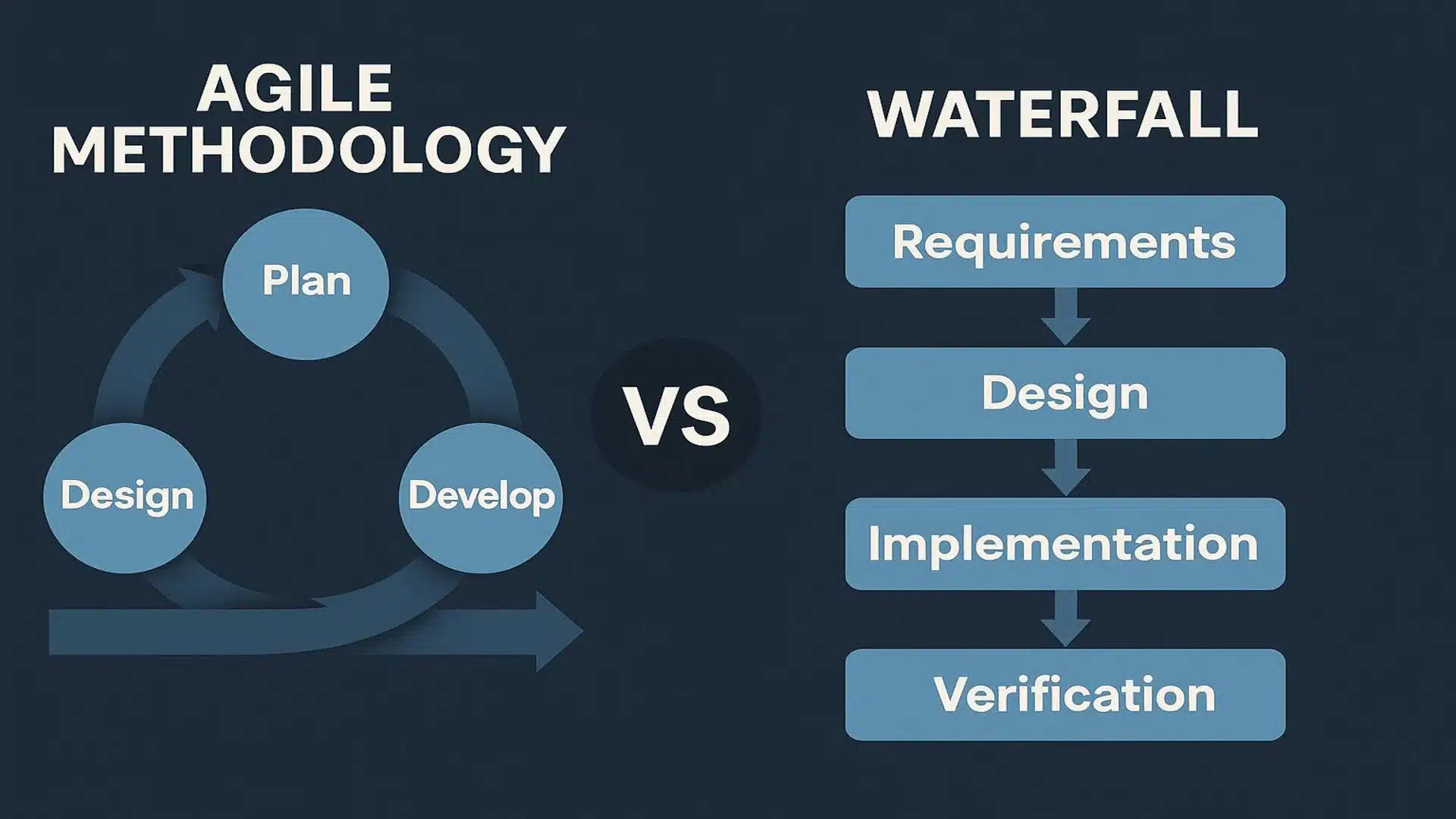Agile Methodology vs Waterfall: A Complete Comparison by Cloudester

Image Credit: openai.com
Table of Contents
- An understanding of Agile methodology
- Key Characteristics
- Common Frameworks
- The Advantages of Agile methodologies
- The Disadvantages of Agile methodologies
- An understanding of Waterfall Methodology
- Key Characteristics
- Typical Phases:
- The Advantages of Waterfall Methodology
- The Disadvantages of Waterfall Methodology
- Key Differences Between Agile and Waterfall Methodology
- 1. Approach to Planning and Execution
- 2. Flexibility and Adaptability:
- 3. Customer Involvement and Feedback:
- 4. Risk Management:
- 5. Documentation Requirements:
- Pros and Cons of Agile vs Waterfall
- Agile Pros:
- Agile Cons:
- Waterfall Pros:
- Waterfall Cons:
- Choosing the Right Methodology for Your Project
- 1. Project Size and Complexity
- 2. Client Requirements:
- 3. Team Expertise:
- 4. Hybrid Approaches:
- Case Studies of Agile and Waterfall Methodology
- 1. Agile Success Example:
- 2. Waterfall Success Example:
- Conclusion
When it comes to project management, choosing the right approach can make or break a project’s success. One of the most debated comparisons in the field is Agile Methodology vs Waterfall. These two widely used project management methodologies have guided countless development initiatives, each offering unique benefits and challenges.
And when it comes to Agile Methodology vs Waterfall, it is a matter of an ongoing debate.
Each method offers its own advantages and disadvantages, so understanding the differences helps you choose the best option for your project.
Here, in this blog, we will delve deep into these two methods, comparing their characteristics, pros, and cons. We will also talk about how they differ from each other, and how you can make the right choice based on your project’s specific needs.
An understanding of Agile methodology
Agile Methodology is a flexible, iterative approach to software development. Agile encourages continuous delivery and adaptation, enabling teams to respond quickly to changes in requirements, technology, or market conditions.
Key Characteristics
- Iterative Development: Agile uses short development cycles or “sprints” to deliver small, functional portions of the product incrementally.
- Continuous Feedback: It involves frequent reviews, ensuring customer feedback is gathered and used to improve the product with every iteration.
- Flexibility: Changes in project scope or features can be made at any stage in development, making Agile ideal for projects with evolving requirements.
Common Frameworks
- Scrum: Focuses on defined roles and time-boxed iterations, facilitating collaboration and accountability.
- Kanban: Uses visual boards to track workflow and prioritize tasks, offering a continuous flow of work.
Custom AI Software Development Solution For Enterprises
The Advantages of Agile methodologies
- Faster Releases: Because of its iterative nature, Agile allows for quicker releases, giving stakeholders access to working products faster.
- Better Adaptation to Changes: Agile projects can easily adjust based on customer or market feedback.
- Higher Customer Satisfaction: Due to regular involvement and feedback, customers are more likely to be satisfied with the final product.
The Disadvantages of Agile methodologies
- Resource Intensive: The continuous involvement of teams and clients can make Agile resource-intensive.
- Scope Creep: Due to constant changes and iterations, the project scope can expand beyond the original requirements.
- Challenges with Documentation: Because Agile is focused on development rather than documentation, it may lack detailed records.
An understanding of Waterfall Methodology
The Waterfall Model is one of the most traditional and structured approaches to project management. It follows a linear, sequential process, where each phase depends on the deliverables from the previous one.
Key Characteristics
- Sequential Phases: The project follows a step-by-step process: requirements gathering, design, development, testing, deployment, and maintenance.
- Rigid Structure: Each phase is completed before moving to the next, meaning there is little room for change once the project has started.
Typical Phases:
- Requirements: The project’s scope and needs are defined at the outset.
- Design: The overall system and architecture are designed.
- Implementation: The system is built according to the design.
- Testing: The system is thoroughly tested to find any issues.
- Deployment: The system is deployed and put into operation.
- Maintenance: Post-deployment support and maintenance are provided.
The Advantages of Waterfall Methodology
- Clear Structure: The rigid, structured approach makes it easy to understand, especially for projects with well-defined requirements.
- Easy to Manage: Due to its step-by-step nature, Waterfall is easier to manage and track, with clear milestones.
- Ideal for Fixed Requirements: For projects with clear, unchanging requirements, Waterfall can deliver efficient results.
The Disadvantages of Waterfall Methodology
- Lack of Flexibility: Once a phase is completed, it’s difficult to go back and make changes.
- Delayed Delivery: The product is only fully delivered at the end of the process, meaning that stakeholders don’t see a working product until the project is complete.
- Limited Customer Feedback: The customer is typically involved only in the early stages, which can lead to dissatisfaction if their needs change during the development process.
Key Differences Between Agile and Waterfall Methodology
The Agile vs Waterfall debate comes down to flexibility, customer involvement, and adaptability. Here’s how they differ:
1. Approach to Planning and Execution
Waterfall follows a strict, linear plan, while Agile is iterative, allowing for constant changes and adjustments.
2. Flexibility and Adaptability:
Agile is highly flexible, adapting quickly to changing requirements. Waterfall, however, has little room for modifications once the project begins.
3. Customer Involvement and Feedback:
Agile emphasizes continuous customer involvement and feedback. Waterfall has limited customer interaction, with the majority of feedback occurring early in the process.
4. Risk Management:
Agile’s iterative approach allows for identifying and addressing risks early in the process, whereas Waterfall risks might not be discovered until later stages.
5. Documentation Requirements:
Waterfall places heavy emphasis on documentation, while Agile focuses more on working software and less on paperwork.
Pros and Cons of Agile vs Waterfall
Here’s a quick breakdown of the Agile vs Waterfall pros and cons:
Agile Pros:
- Faster delivery with incremental releases.
- Increased flexibility to adapt to changing needs.
- Continuous customer feedback ensures alignment with user expectations.
Agile Cons:
- Requires more resources due to constant iteration and involvement.
- Potential for scope creep if not managed properly.
- Lack of detailed documentation can lead to confusion later in the project.
Waterfall Pros:
- Clear structure and timeline, making it easier to manage.
- Ideal for projects with fixed requirements and no room for change.
- Comprehensive documentation that makes future maintenance easier.
Waterfall Cons:
- Inflexible, with little room for change after the project starts.
- Late delivery of the final product makes it hard for clients to provide feedback.
- Customer satisfaction can be impacted if the product doesn’t meet evolving needs.
Choosing the Right Methodology for Your Project
Selecting the right methodology Agile vs Waterfall depends on several factors:
1. Project Size and Complexity
Large, complex projects with evolving requirements may benefit from Agile, while smaller, well-defined projects may be better suited to Waterfall.
2. Client Requirements:
If your client needs flexibility and frequent updates, Agile is the way to go. If they prefer predictability and a clear timeline, Waterfall might be better.
3. Team Expertise:
Agile requires a team comfortable with flexibility and rapid changes, while Waterfall is better suited for teams that prefer structure and detailed planning.
4. Hybrid Approaches:
Many organizations use a hybrid approach, combining elements of both Agile and Waterfall to suit specific project needs.
Case Studies of Agile and Waterfall Methodology
1. Agile Success Example:
PayPal embraced Scrum methodology for merging its development process with the aim of streamlining bottlenecks, organizational effectiveness, and accelerating product release cycles. With Scrum, there was a noticeable reduction in internal delays and greater employee alignment. As a result, PayPal could expedite its innovation efforts and released 58 new product features within the initial six months of implementation.
2. Waterfall Success Example:
The US Department of Defense (DoD) formerly utilized the waterfall model to a large extent in their software development contracts, notably under the auspices of DOD-STD-2167A, a standard which was utilized for a decade until it was replaced by MIL-STD-498. The methodology placed tremendous emphasis on the design phase of development.
Also read: Why Agile Development is Perfect for Fast-Paced Startups?
Conclusion
In the Agile Methodology vs Waterfall war, there is no clear winner.
The right method depends on the size and complexity of your project, client needs, and the flexibility needed. When your project needs ongoing updates, frequent client involvement, and the ability to switch, Agile is your best option. However, for projects with clear, fixed requirements and a need for exhaustive planning, Waterfall remains a valuable option.
Last but not least, aligning your chosen methodology with your project needs is essential. If you’re unsure, guidance from the experienced team at Cloudester Software, a reliable software development company in USA, will point you in the right direction.









